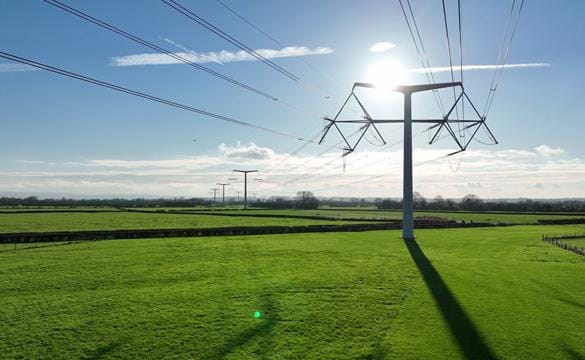The Most Overlooked Invention of Our Time
Over 90,000 tall monolithic structures that cost up to £300,000, stand over 50 metres tall, and carry power for 29.9 million homes, yet they are the most overlooked innovation of our time. Pylons are simply underrated.

Over 90,000 tall monolithic structures that cost up to £300,000, stand over 50 metres tall, and carry power for 29.9 million homes, yet they are the most overlooked innovation of our time. Pylons (Transmission lines) are simply underrated.
Their job is simple: to take electricity from one place and transport it to another. Yet this is only the surface of the iceberg. The world of pylons is a surprisingly secretive, competitive, and fascinating.
The Ancient Origins of Pylons
Ancient Egypt is famous for its architecture, revolutionising and optimising technologies to build magnificent cities. Their culture and architecture still stick with us today, nearly 4000 years later. Pylons start their history here.
Now, these aren't pylons in the same way you and I know them today, but there is an interesting link. Large gateways were developed for ancient Egyptian temples. Pylons took the form of two separate towers with a gate connecting the two. The walls of these towers are slightly inclined to build a strong structure to protect the temple.
The pylons often symbolised a gateway to the afterlife. This idea is what inspired Sir Reginald Blomfield, the designer of the modern pylon, to name our transmission towers pylons. He thought they acted as a gateway to power our nation.
Public opinion
For most people, pylons fade into the background. The public mostly feels indifferent about these structures around them. However, this flips once a new line is attempted to be built; developers are often met with objections.
According to the DESNZ Public Attitudes Tracker (2024), 79% of people understand we need more grid infrastructure. But only 23% feel happy having new pylons built nearby, while 30% said they’d be unhappy. I would like to note, public opinion has improved since 2023, from 20% to 24% in 2024. The main concerns from the public are the impact on the view, making up 61% of the voting reasons. The main reason for support is attributed to enabling the transmission of renewable energy. Those who lived in rural areas were more likely to be unhappy about new pylons.
Public opinion swings based on the usage of the pylon. If the pylon is constructed to transport renewable energy, residents are significantly happier compared to low-carbon and fossil fuel generation.

The new design that hasn't succeeded...yet
As 61% of the negative pylon reviews stem from the impact on the view, surely this should be a clear sign for the National Grid to investigate a new pylon design? The current look was designed in 1928 by the Milliken Brothers. Is it time we change the infamous design to progress the net-zero goal?
The T-pylon represents the UK’s first major electricity pylon redesign in nearly a century, aiming to modernise the grid while reducing visual impact. In 2011, the UK government, National Grid, and the Royal Institute of British Architects launched an international competition to create a more aesthetically pleasing pylon. Danish firm Bystrup won with the T-pylon design, featuring a single 35-meter pole with T-shaped arms and diamond-shaped insulators. This design is approximately one-third shorter than traditional lattice pylons and occupies a smaller land footprint.
The T-pylon’s debut was part of the Hinkley Connection Project, a £900 million initiative to connect Hinkley Point C nuclear power station to the grid. Spanning 57 km from Bridgwater to Seabank near Avonmouth, the project includes 116 T-pylons, underground cables, and a new substation. The first 36 pylons were energised in 2022, with the remainder completed by 2024.
Public response to T-pylons has been mixed. The aesthetic appeal is better rated. A YouGov poll indicated that 59% of respondents viewed the T-pylon design positively, compared to 36% for traditional pylons. Cost and Practicality: Despite their design benefits, T-pylons have faced criticism over higher costs and construction complexities compared to traditional pylons.
But...T-pylons aren't sticking; in fact, the National Grid is planning to abandon them. They have a few issues to address before possible mass adoption. The Hinkley Connection Project reportedly would cost an extra £65 million compared to using lattice pylons, mainly due to the extra material needed to construct the pylons. Neighbouring residents are complaining about a whistling noise in high winds, some saying the noise is "Horrid" and "Spooky". Each issue adds hurdles to the National Grid expansion and may cause time delays.
T-Pylons no longer feature as a pylon design in our net-zero future.
The Politics Behind the Power Lines
For something as practical as moving electricity from A to B, pylons are surprisingly political. They spark debate in town halls, fuel local opposition groups, and clog up infrastructure plans meant to help the UK hit net zero. Why? Because nobody wants one in their back garden.
It’s the classic tension: we all want clean, reliable electricity, but not the towering steel structures that come with it. Residents often push back against new transmission lines over visual impact, land devaluation, or heritage concerns. Projects can face years of delays from planning appeals, legal challenges, and public inquiries.
The stakes are bigger than one pylon in one field. Without new infrastructure, renewable projects can’t plug into the grid. As of 2024, over 300GW of clean energy is stuck waiting for grid connections in the UK. Some wind and solar farms face 10–15 year wait times to get connected. This bottleneck is one of the biggest threats to the UK’s climate targets.
The government is starting to notice. The UK Energy Security Strategy now pushes for “faster transmission builds.” But that means: changing public perception, reforming planning laws, and facing down local resistance. The truth is, you can’t electrify everything, EVs, heat pumps, industry, without more pylons. And that means someone, somewhere, has to say yes.
A Surprisingly Competitive and Secretive World
Despite their stillness, pylons sit at the centre of a fast-moving, fiercely competitive industry, one that’s more secretive than you’d expect.
The companies that design, manufacture, and install transmission towers operate in a high-stakes world. Contracts are worth millions, timelines are politically sensitive, and the engineering margins for failure are razor-thin. Winning a bid to supply pylons for a project like the Hinkley Connection or offshore wind expansion can make or break a firm.
And yet, almost nothing about this world is public.
Designs are often proprietary. Supply chain details are buried in non-disclosure agreements. Even the exact material choices, cost breakdowns, and structural innovations are usually closely guarded. National Grid releases carefully curated public updates, but behind the scenes, it’s a mix of corporate NDAs, engineering rivalry, and regulatory red tape.
Think of it like Formula 1, but instead of speed, it’s about strength, cost, and how fast you can install steel in muddy fields.
This secrecy makes it hard to innovate quickly. Companies don’t want to share what works, even when it might help the whole grid evolve. That’s partly why the T-pylon, despite being a public design competition winner, stumbled when it came to scale: too few players, too many risks, not enough shared knowledge.
What does the future look like?
If I were a betting man, I’d say pylons, as we know them, aren’t going anywhere. The fundamentals work. While materials may evolve and monitoring improves, the basic design is here to stay.
Underground transmission will grow, especially as public resistance to visible infrastructure remains high. It’s a cleaner, quieter solution, but the massive cost means pylons will remain the go-to for now.
That said, public opinion is shifting. As pylons become symbols of the green transition rather than industrial eyesores, acceptance is rising. If that continues, we could see faster grid expansion and with it, a smoother path to a fully renewable future.
We ignore them, complain about them, and often fight to keep them out of sight. But pylons power the present and the future too. Whether they rise taller or disappear underground, they’ll be central to the grid that keeps us going.
Thank you for reading, Matthew.
Feel free to get in touch, mjfrost@silkmod.com. If I missed anything or got something wrong, it would be great to hear from you.



